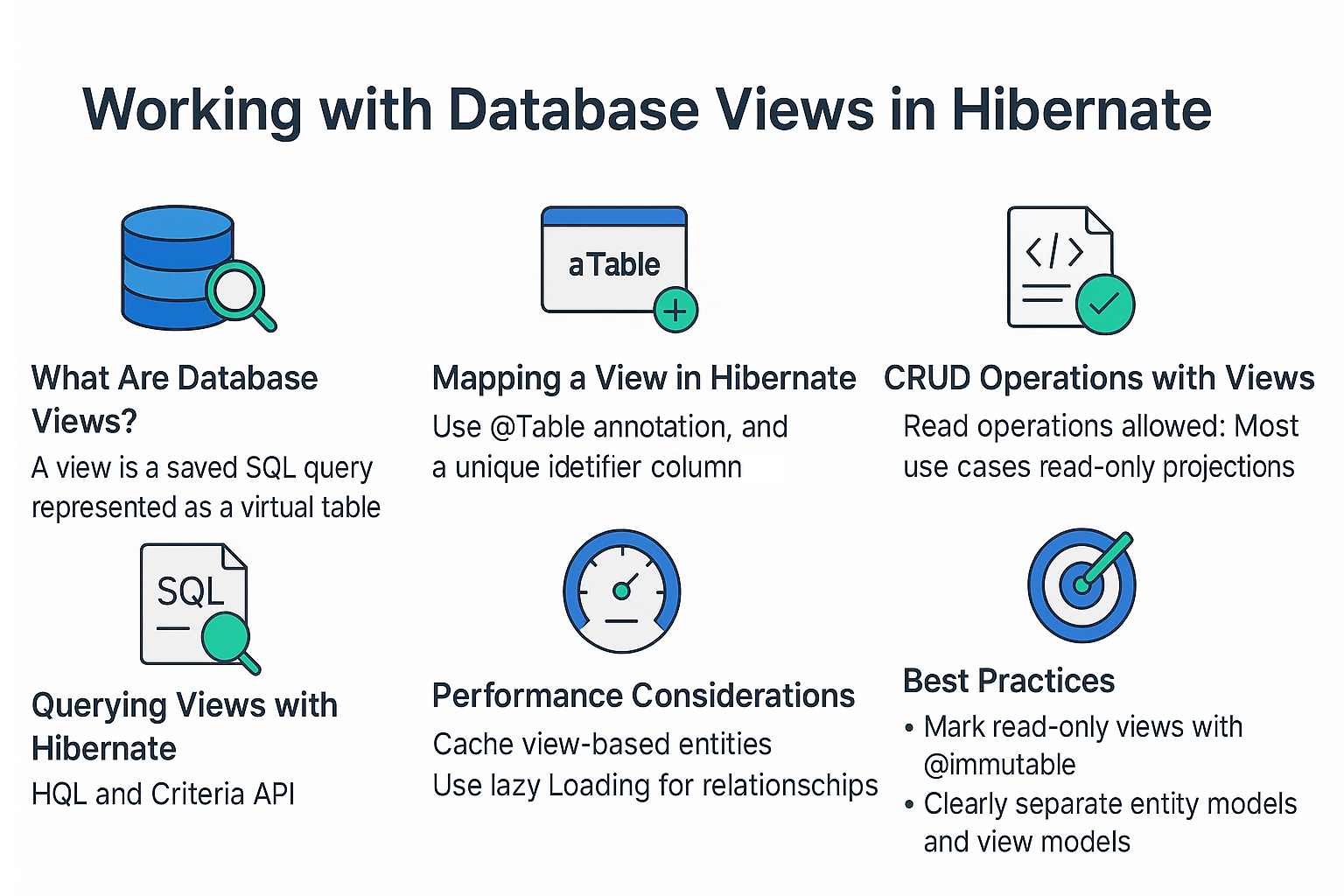When working with relational databases, developers often encounter views — virtual tables created from queries that combine and filter data. Unlike normal tables, views don’t store data directly; instead, they present a snapshot of data derived from one or more base tables.
In Hibernate, database views can be mapped and queried just like tables, offering a powerful way to simplify complex SQL logic, enforce security, and improve maintainability. This tutorial walks through the complete process of using views with Hibernate, from setup to advanced performance considerations.
What Are Database Views?
- Definition: A view is a saved SQL query represented as a virtual table.
- Purpose: They encapsulate complex joins, aggregations, and filters into a single object.
- Example: Instead of repeating a multi-table join in multiple queries, you can create a view and map it as an entity in Hibernate.
Analogy: Think of a view as a "window" into your database — you don’t duplicate the room (data), but you get a different perspective on it.
Setting Up a View in SQL
CREATE VIEW employee_summary AS
SELECT e.id, e.name, d.name AS department, s.salary
FROM employees e
JOIN departments d ON e.dept_id = d.id
JOIN salaries s ON e.id = s.emp_id;
This creates a read-only view summarizing employees with their department and salary.
Mapping a View in Hibernate
Entity Class Mapping
import jakarta.persistence.Entity;
import jakarta.persistence.Id;
import jakarta.persistence.Table;
@Entity
@Table(name = "employee_summary")
public class EmployeeSummary {
@Id
private Long id;
private String name;
private String department;
private Double salary;
// getters and setters
}
Notes:
@Tablecan point directly to the view name.- Every view must have a unique identifier column (
@Id). If the view doesn’t provide one, you may need to use a composite key or generate a surrogate.
CRUD Operations with Views
- Read (Allowed): You can query data directly from a view.
- Create/Update/Delete: Generally not allowed unless the view is updatable.
// Fetch using Hibernate Session
Session session = sessionFactory.openSession();
List<EmployeeSummary> list = session.createQuery("from EmployeeSummary", EmployeeSummary.class).list();
Most use cases are read-only projections. Mark your entity as read-only to avoid accidental persistence:
import org.hibernate.annotations.Immutable;
@Entity
@Immutable
@Table(name = "employee_summary")
public class EmployeeSummary {
// fields...
}
Querying Views with Hibernate
HQL
String hql = "FROM EmployeeSummary WHERE department = :dept";
List<EmployeeSummary> employees = session.createQuery(hql, EmployeeSummary.class)
.setParameter("dept", "Engineering")
.list();
Criteria API
CriteriaBuilder cb = session.getCriteriaBuilder();
CriteriaQuery<EmployeeSummary> cq = cb.createQuery(EmployeeSummary.class);
Root<EmployeeSummary> root = cq.from(EmployeeSummary.class);
cq.select(root).where(cb.equal(root.get("department"), "Engineering"));
List<EmployeeSummary> result = session.createQuery(cq).getResultList();
Performance Considerations
- Caching: Mark view-based entities as cacheable if data doesn’t change often.
- Lazy Loading: Use lazy fetching for relationships. Think of it like "ordering food only when you need it".
- Materialized Views: If queries are expensive, consider materialized views for faster reads.
@Cacheable
@Entity
@Immutable
@Table(name = "employee_summary")
public class EmployeeSummary { ... }
Real-World Integration with Spring Boot
@Repository
public interface EmployeeSummaryRepository extends JpaRepository<EmployeeSummary, Long> {
List<EmployeeSummary> findByDepartment(String department);
}
Spring Boot + Spring Data JPA makes querying views seamless, leveraging repository patterns.
Common Pitfalls and Anti-Patterns
- Using views for frequently changing transactional data → better to stick with base tables.
- Not defining a proper primary key in the view → Hibernate requires an identifier.
- Misusing eager fetching with large views → can cause N+1 select issues.
- Trying to perform inserts/updates on non-updatable views.
Best Practices
- Always mark read-only views with
@Immutable. - Use caching for performance on static or slowly-changing views.
- Clearly separate entity models and view models to avoid confusion.
- Consider DTO projections if the view only supports reporting.
📌 Hibernate Version Notes
Hibernate 5.x
SessionFactorytypically configured viahibernate.cfg.xml.- Uses
javax.persistenceannotations. - Legacy Criteria API widely used.
Hibernate 6.x
- Moved to Jakarta Persistence (
jakarta.persistence). - Enhanced query capabilities with better SQL support.
- Streamlined bootstrapping and new query APIs.
Conclusion and Key Takeaways
- Database views help simplify complex queries and encapsulate business logic.
- Hibernate can map views just like tables, but operations are usually read-only.
- Mark entities as
@Immutableand ensure they have a unique identifier. - Combine with Spring Boot repositories for clean integration.
- Hibernate 6 introduces Jakarta Persistence and enhanced query support.
Key Takeaway: Use Hibernate with views for reporting, projections, and read-optimized queries, but avoid using them for transactional writes.
FAQ: Expert-Level Questions
1. What’s the difference between Hibernate and JPA?
Hibernate is an implementation of JPA (a specification). JPA provides the standard, Hibernate provides the working framework.
2. How does Hibernate caching improve performance?
Caching avoids hitting the database repeatedly by storing entities/queries in memory (first-level and second-level cache).
3. What are the drawbacks of eager fetching?
It loads related entities immediately, which can cause performance issues (N+1 selects).
4. How do I solve the N+1 select problem in Hibernate?
Use JOIN FETCH in HQL, batch fetching, or entity graphs.
5. Can I use Hibernate without Spring?
Yes, Hibernate works standalone, but Spring Boot simplifies configuration and transaction management.
6. What’s the best strategy for inheritance mapping?
Depends: SINGLE_TABLE for performance, JOINED for normalization, TABLE_PER_CLASS for flexibility.
7. How does Hibernate handle composite keys?
Via @Embeddable and @EmbeddedId, or @IdClass.
8. How is Hibernate 6 different from Hibernate 5?
Hibernate 6 uses Jakarta Persistence, has enhanced query support, and modernized bootstrapping.
9. Is Hibernate suitable for microservices?
Yes, but be careful with caching and distributed transactions. Consider lightweight JPA usage.
10. When should I not use Hibernate?
When raw SQL performance is critical, or schema-less/noSQL flexibility is required.
